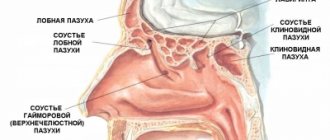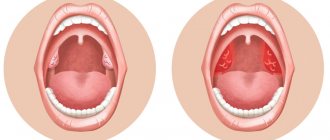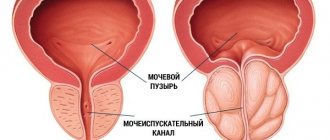Forms of pharyngitis
According to its clinical course, pharyngitis can be chronic and acute.
The chronic form is divided into:
- hypertrophic – this is an increase in mucous membrane;
- atrophic – this is the depletion of the mucous membrane;
- catarrhal – standard inflammation.
The acute form also exists in three types:
- allergic – provoked by allergens;
- infectious – caused by pathogenic microorganisms;
- post-traumatic – occurs due to contact with the mucous membrane of irritating substances.
Inhalations
This is one of the simple and affordable methods of treating pharyngitis. Traditional inhalation methods offer many recipes. It is important to remember that steam inhalation can only be performed in the absence of elevated temperature.
- In a standard glass of warm water, mix one half tablespoon of baking soda, salt and a couple of drops of iodine. A sea salt solution also works great. The proportions are the same.
- Use an infusion from a collection of herbs: sage, coltsfoot, eucalyptus, mint, viburnum, linden. It is necessary to add six teaspoons of crushed pharmaceutical herbs to one liter of water. Leave in a steam bath for ten minutes.
- An infusion of pine buds is a storehouse of vitamin C and is suitable for inhalation. Prepare the solution: 2 tbsp. l. raw materials for one glass of boiling water.
- Essential oils of menthol, peach, oak bark, and juniper are widely used for antiviral and disinfecting results. Three drops per glass of hot water is enough.
- Both adults and children will benefit from aerosol inhalations of Lake Shira mineral salt from Shirline dry concentrate. Make a 1% warm solution (38-40 degrees). Every day for children for 5-7 minutes, for adults 10-15 minutes. You can do it 2 times a day. The course of treatment is 12 – 20 procedures.
Reasons for the development of the disease
In most cases, acute pharyngitis does not act as an independent pathology, but is only a manifestation of a general infectious process. Many infections (diphtheria, scarlet fever, measles, influenza) debut as an acute form of pharyngitis and are therefore not diagnosed in a timely manner.
In 70% of cases, acute inflammation of the pharynx is caused not by bacteria, but by viruses. Most often this is:
- influenza and parainfluenza viruses;
- rhinoviruses;
- adenoviruses;
- Epstein-Bar viruses;
- cytomegalovirus family;
- enteroviruses.
Only 30% of cases of acute pharyngitis are caused by bacterial flora:
- staphylococci;
- pneumococci;
- streptococci of groups A, C, G;
- Corynebacterium diphtheria;
- hemophilus influenzae;
- atypical pathogens are chlamydia and mycoplasma.
The latter are called atypical, because settle inside cells, and not on the surface of the mucosa, so the immune system cannot detect them. For this reason, such inflammatory processes take a long time, creating significant difficulties in carrying out etiotropic (acting on the cause) therapy.
In a small percentage of cases, pharyngitis is caused by fungal flora. As a rule, this is due to a general weakening of the immune system or local immunodeficiency (for example, in smokers). This is also facilitated by long-term use of antibacterial drugs.
If not treated correctly, acute pharyngitis can become chronic. Most often, pharyngitis caused by cytomegalovirus infection, Epstein-Barr virus, chlamydial and mycoplasma infection is chronic, since these microorganisms live inside cells and are not affected by local antibacterial and antiviral therapy. But inflammation caused by streptococci and staphylococci can also become chronic.
The development of chronic pharyngitis is a consequence of one of two processes:
- chronicity of acute inflammation of the pharynx due to poor immune defense;
- secondary infection of the pharynx from infectious foci located in the body (carious teeth, inflammation of the ENT organs, diseases of the digestive tract, etc.).
Factors that increase the likelihood of pharyngitis:
- hypothermia of the whole body or only the upper respiratory tract;
- alcohol abuse;
- eating sour, spicy, hot or cold foods;
- nasal breathing disorder.
Breathing through the nose becomes difficult in conditions such as:
- deviated nasal septum;
- nasal polyps;
- hypertrophy of the inferior turbinates;
- allergic rhinitis.
In these cases, a person has to breathe through his mouth, and this dries out the oral mucosa and reduces local immunity, because The production of immunoglobulin A decreases.
Atrophic pharyngitis is also provoked by other causative factors:
- lack of vitamins;
- anemia;
- functional heart failure;
- renal failure;
- diabetes;
- decreased thyroid function (hypothyroidism);
- menopausal syndrome.
Recommendations for the occurrence of pharyngitis in adults and children
Soreness and dryness, as the first symptoms of an acute inflammatory process, can be alleviated:
- drinking plenty of warm liquids;
- rinsing with saline solutions or antiseptics;
- using painkillers in the form of lozenges;
- active humidification of the air in the room.
Uncomplicated acute pharyngitis does not always require medical intervention. With the right approach, you can independently cope with the symptoms and achieve a full recovery. But the absolute criterion for visiting a doctor, especially when treating pharyngitis in children, is the appearance of respiratory problems.
If inflammatory symptoms do not subside within 48 hours, and after starting active therapy you notice an increase in pain, you should also contact an otolaryngologist. If intensive treatment measures are not taken in a timely manner, the risk of developing serious complications increases. Inflammation of the trachea, middle ear or bronchial tree, as well as purulent abscesses on the tonsils or in the retropharyngeal space will require surgical intervention.
Clinical picture
The acute form manifests itself:
- sore throat, which sometimes radiates to the ears if the lateral pharyngeal ridges become inflamed;
- a feeling of tickling and burning;
- dryness and discomfort in the throat;
- slight rise in temperature (usually no more than 38.0°C).
When palpating the lymph nodes of the neck, they are determined to be enlarged and painful. Examination of the pharynx reveals redness of its posterior wall and palatine arches, granularity is clearly visible (enlarged lymphoid foci of a brighter color than the surrounding mucosa). An important differential sign is the absence of inflammation in the tonsils with pharyngitis. This distinguishes it from a sore throat.
Chronic inflammatory lesions of the pharynx are easier than acute ones - fever and general deterioration in health are almost always absent. Usually the patient is concerned about:
- feeling of dryness and sore throat;
- dry cough with attacks;
- sensation of a lump or foreign body in the throat.
Due to the fact that mucous secretion accumulates on the back wall, a person constantly needs to swallow it. This causes significant discomfort.
The atrophic type of pharyngitis is accompanied by thinning and dryness of the mucous membrane, through which the vessels are visible. On its surface there may be crusts of dried mucous secretion.
The hypertrophic form is diagnosed by the presence of overgrown foci of lymphoid tissue, which are determined in the form of granules or strands. They are located behind the lateral pharyngeal ridges (these are the posterior arches of the palate). During an exacerbation, hyperplastic areas swell, increase in size, acquire a bright pink color, and foci of abscess formation may appear in them.
Methods of treating throat in children
You should start treating your baby only after consulting a pediatrician. Home therapy for a child includes more gentle methods.
First of all, it is necessary to provide warm drink . Not strong chamomile tea is the most suitable drink for this. Brew one teaspoon of medicinal plant in a glass of water.
When gargling, use the mixture (plantain and calendula flower). Steam a tablespoon of dried herb with boiling water (200 ml). Leave in a thermos for one hour. Strain the infusion. Carry out the procedure in the morning and evening. A solution of sea salt is also a good antiseptic. To prepare it, stir one third of a teaspoon in a glass of water. Apply according to the above described scheme.
The compress is quite effective for coughing, which often accompanies pharyngitis. You will need boiled potatoes, pre-finely chopped (you can use peelings). Place in a plastic bag, tie and wrap in several layers of fabric. Place it on your chest and secure it. It should be pleasantly warm, but not hot. Warm up for one hour. Adjust the temperature of the compress by removing layers of fabric, as it will cool over time. After completing several procedures, you will get rid of cough.
Inhalations for children are carried out using wild rosemary, St. John's wort, mint, oregano (plants can be mixed). Brew medicinal herbs at the rate of three tablespoons of herbs per liter of just boiled water.
Diagnosis of pharyngitis
In the diagnosis of acute pharyngitis, pharyngoscopy, determination of the pathogen (PCR, bacteriological and mycological examination of smears from the pharyngeal mucosa) and laboratory examination (clinical blood test, inflammatory markers, general urine analysis) are of key importance. The data obtained during diagnosis allows you to select the correct treatment, avoid complications and chronicity of the process.
In the diagnosis of chronic pharyngitis, the search for primary foci of infection is important. For this purpose the following is carried out:
- X-ray examination of the nasal cavity, paranasal sinuses and oral cavity (computed tomography of the paranasal sinuses, dental CT);
- endoscopic examination of the nasopharynx;
- esophagogastroduodenoscopy.
A detailed laboratory examination is carried out. In addition to a clinical blood test, it is necessary to conduct an examination for chronic viral infections and intracellular bacterial infections, and exclude the allergenic factor.
In some cases, a detailed examination of the immune system is required, since a decrease in local immunity leads to chronic infection.
How otolaryngologists at SM-Clinic treat pharyngitis
The basis of treatment for acute uncomplicated pharyngitis is symptomatic therapy:
- warm drink;
- inhalations and rinses with anti-inflammatory and anesthetic compounds, for example, menthol;
- applying antiseptics to the mucous membrane of the pharynx;
- physiotherapeutic measures;
- a diet excluding spicy, too hot or too cold foods.
Antibiotics for acute pharyngitis are prescribed only in cases where microbiological analysis of a pharyngeal smear confirms the bacterial nature of the disease. Often there is no need for systemic use of such drugs (tablets, intramuscular injections). Local use of nonspecific antimicrobial agents (chlorhexidine solution, essential oils, medicinal plants, calendula, eucalyptus and chamomile preparations) is sufficient.
If there is a significant increase in body temperature, antipyretic therapy is indicated. In more serious cases, with increasing swelling of the mucous membrane and allergic reactions, antihistamines are prescribed.
For the treatment of chronic pharyngitis in adults, lifestyle is of utmost importance. An unconditional cessation of smoking, changing the patient's diet, and taking care of the temperature are necessary. It is imperative to get rid of other foci of infection in the body and sanitize the oral cavity. To treat indolent inflammatory phenomena in the pharyngeal mucosa, a course of corticosteroids is sometimes used. In the hypertrophic form of chronic pharyngitis, SM-Clinic doctors can cauterize the overgrown lymphoid tissues with liquid nitrogen or an electric loop.
Prevention
To prevent pharyngitis, it is enough to follow some simple rules:
- protect the body from hypothermia;
- limit contact with sick people;
- stop smoking;
- wash your hands regularly (especially before eating);
- maintain body hygiene;
- carry out wet cleaning in the house;
- ventilate the room;
- drink enough liquid.
To avoid illness, you should take care of your health, eat well and take vitamins.
1.General information
The pharynx (Latin “pharynx”) in anatomy refers to the gradually narrowing downward space between the oral cavity and the larynx.
Accordingly, pharyngitis is an inflammatory process in this area, covering the mucous membrane and lymphoid tissues.
A general overview of inflammation localized in the pharynx is contained on our website in the material “Pharingitis”.
Chronic pharyngitis is less common than acute pharyngitis and affects mainly adults or the elderly. According to some sources, the incidence does not depend on gender; according to others, men are more likely to suffer from chronic tonsillitis.
Despite a certain symptomatic similarity with the acute form, chronic tonsillitis has its own etiopathogenetic and clinical specificity, representing an independent disease and an independent nosological unit in the International Classification of Diseases (ICD).
A must read! Help with treatment and hospitalization!











